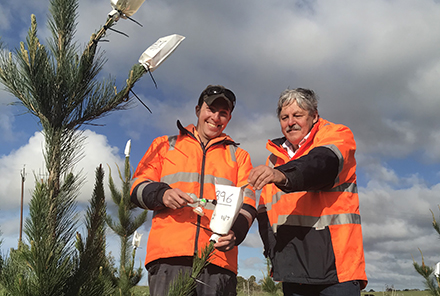
Tree Breeding Australia field technician David McKersie with general manager Dr Tony McRae, undertaking the cross-pollination process.
More than 1500 white bags are being carefully fitted to the flowering stems of radiata pine trees grafted in orchards in Mount Gambier in an important step towards creating superior genetics to grow the next generation of Green Triangle forests. Source: Timberbiz
In what could be disguised by the distant eye as cockatoos grazing in the trees, these important isolation bags have been fitted by Tree Breeding Australia (TBA) field technicians in recent weeks at the Kilsby Road breeding site to provide the important pathway for effective cross pollination.
TBA is Australia’s leading research organisation, managing national tree improvement programs for radiata pine and blue gum and providing genetic evaluations to guide business development in the forestry sector.
TBA general manager Dr Tony McRae said the cross pollination or mating process involved taking elite male pollen, isolating the superior female flower and artificially pollinating it by injecting pollen, all trapped by the walls of the white pouch.
The pollination process occurs three times before the bags are removed with crews returning two years later to harvest the pine cone and draw out the seed which is then used in planting trials.
“We have worked for a number of years on generating superior genetics, identifying trees with the best growth rates, smaller branches, straighter growth habits, higher wood density and stiffness to suit the needs of forest growers. It’s these genes which are being used to pollinate these trees,” Dr McRae said.
“There is significant work undertaken in picking the right combination of genes, including examining their DNA sequence and ensuring it is mated with an appropriate unrelated partner that will result in the best breeding outcome.”
The results of this breeding research is shared globally, with companies in France and Sweden who want to learn from the Green Triangle’s research and generation of high-grade timber.
For more than three decades TBA have been working with forest growers to optimise their genetics to suit the local climate and environment to generate financial returns.
Working with NIFPI and the Green Triangle Forest Industries Hub, TBA research was now looking at how to use genomics in combination with conventional breeding to increase productivity and further strengthen radiata fibre for greater commercial building use.
GTFIH acting chair Ian McDonnell said the ‘genetic revolution’ was going to further build the Green Triangle’s profile as a world leader in the generation of sustainable high-grade log.
“There have been amazing innovations in our sector over recent decades but the years ahead look to be the most advanced yet,” Mr McDonnell said.
“This cross pollination is providing the pathway to generating superior wood that grows straighter and faster, provides stronger fibre and results in zero waste meaning more profitable outcomes for our growers and processors.
“This world class research by TBA is going to ensure our forest sector can continue to grow and thrive, creating new jobs for the next generation.”





